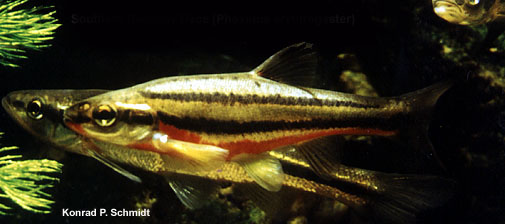| Leuciscidae (Minnows), subfamily: Laviniinae |
| 9.1 cm TL (male/unsexed); max. reported age: 3 years |
|
demersal; freshwater |
| North America: Basins of Lakes Erie and Michigan and Mississippi River from New York to Minnesota, south to Tennessee River drainage in Albama, and White and Arkansas River drainages in Arizona and Oklahoma, USA. Isolated populations on Former Mississippi Embayment in Tennessee, Mississippi and Arkansas; Kansas River system in Kansas; and upper Arkansas River drainage in Colorado and New Mexico, USA. |
|
Chrosomus erythrogaster can be distinguished by having the following characters: 67-95 scales on lateral line; pharyngeal teeth 0,5-5,0; moderately pointed snout, longer than eye in adult; small, moderately oblique (less than 45°), slightly subterminal mouth ending in front eye; 2 black stripes along side with upper one thin broken into spots at rear while lower one wide, becoming thin on caudal peduncle; olive brown above, dusky stripe along back; black spots (sometimes absent) on upper side, often arranged in row; silver yellow side; black wedge-shaped caudal spot; white, yellow or red below; and large males with vivid color, consisting of bright red belly, lower head and base of dorsal fin, and yellow fins (Ref. 86798). |
| Inhabits rocky, usually spring-fed, pools of headwaters and creeks (Ref. 86798). Also found in streams (Ref. 10294). |
|
Least Concern (LC); Date assessed: 03 November 2011 Ref. (130435)
|
| harmless |
|
Source and more info: www.fishbase.org. For personal, classroom, and other internal use only. Not for publication.

